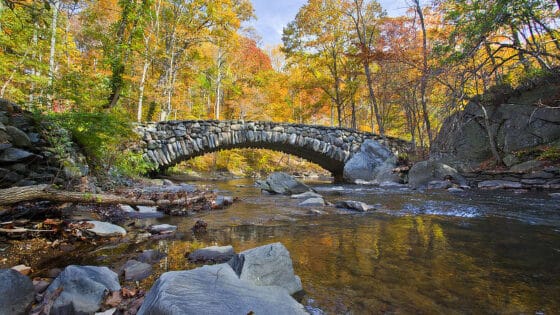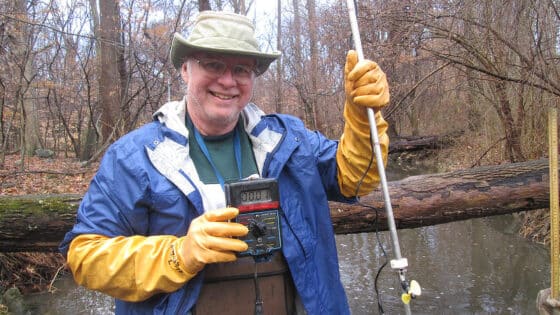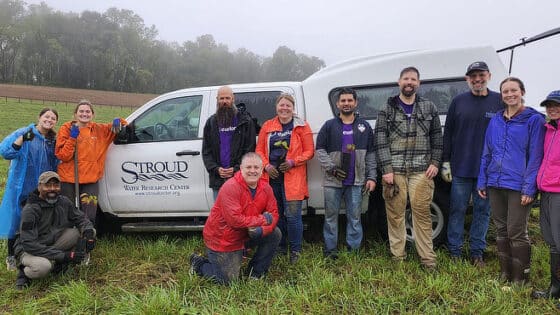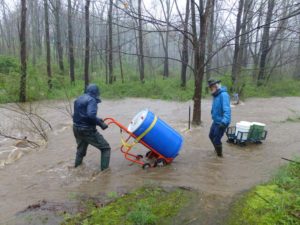
Once upon a time, in the field of freshwater science, researchers measured the discharge of fresh water by hanging a sensor from a bridge or by wading in rivers and streams to collect enough measurements and make their calculations.
It was tedious, potentially dangerous — but necessary.
A fundamental measurement in environmental-monitoring projects, discharge is the amount of water that travels through a cross-section of stream over a given time.
Flow Determines Amount of Habitat Available for Aquatic Life
To tackle detailed research projects, scientists must understand and measure basic information such as discharge and the speed of the water, which are critical features of stream ecosystems.
For example, low and high flows affect the form and function of stream channels and influence what kinds of freshwater fish, bugs and microbes may, or may not, thrive, in streams. Ultimately, flow determines the amount of stream habitat available for aquatic species, and long-term changes to land use and climate in a watershed can alter stream function and health.
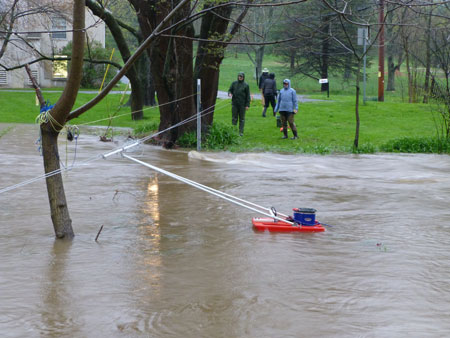
“We often use liters per second as our unit measurement for stream discharge, but you could fill a coffee cup with water from your tap and measure the discharge in coffee cups per second,” explains Melinda Daniels, Ph.D., the associate research scientist who heads the Fluvial Geomorphology Group at the Stroud Center. “Mathematically, we can calculate discharge very well if we know the width and depth of a cross-section of stream and the velocity fields in that cross-section.”
“We want to know how much water flows downstream. Without a Doppler instrument, that is very difficult, if not impossible, to measure safely and rapidly,” Daniels said.
THE SOUND WAVES OF THE FUTURE
Fortunately, evolving technology has made determining discharge easier, safer and more accurate.
Today, staff scientists Dave Montgomery and Sara Damiano tow a small red, white and blue object across White Clay Creek. Though it looks like a simple child-sized boat, this instrument is no toy — but a sophisticated piece of equipment for measuring discharge.

The Teledyne RD Instruments StreamPro ADCP, an acoustic Doppler current profiler, floats in the stream and is attached to a steel-cable pulley system that hangs like a clothesline several feet in the air above and across the stream. Slowly and steadily, the ADCP is towed from one side of the stream to the other.
As it travels, it emits and measures Doppler sound waves that bounce off particles in the water and off the stream bottom to determine water velocity, depth and location across the channel to calculate discharge.
Scientists enter other details about the channel width and the starting and ending position into the ADCP’s handheld computer system, and the boat communicates with the computer, revealing the data in real time.
“We do this several times a year,” Montgomery says as he lifts the ADCP out of the water. “Each time, we measure at a different water level — during a storm when water levels are high, during dry periods, all four seasons — to get a complete profile of the stream’s discharge throughout the year.”
“It’s pretty cool what technology can do today. Safety and accuracy are the biggest benefits of this instrument.”
Give the Gift of Technology
Help support our research efforts by donating toward the tools and equipment we need to monitor and ultimately protect our freshwater systems.

